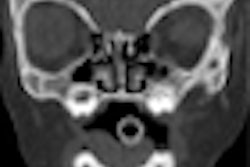While the radiation dose for a CT fluoroscopy exam is about half the dose required for conventional fluoroscopy to guide epidural steroid injections, it's four times more than conventional fluoroscopy when a full lumbar spine planning CT scan is performed as part of the CT-guided procedure, according to a study published in the October issue of the American Journal of Roentgenology.
As a result, radiologists performing CT fluoroscopy should consider techniques to reduce radiation dose for the planning CT, such as reducing the coverage only to areas of interest and reducing the tube current or peak kilovoltage, according to Dr. Jenny Hoang of Duke University Medical Center and colleagues
Hoang's group compared the radiation dose of conventional fluoroscopy-guided lumbar epidural steroid injections and CT fluoroscopy-guided lumbar epidural steroid injections using both clinical data and anthropomorphic phantoms. The researchers retrospectively reviewed dose parameters for 14 conventional fluoroscopy injections performed by one clinician and 42 CT fluoroscopy-guided injections performed by three clinicians (14 each) (AJR, October 2011, Vol. 197:4, pp. 778-782).
The study team found that although physicians may hesitate to use CT fluoroscopy because of radiation dose fears, its radiation dose is actually much lower, as CT fluoroscopy itself takes less time than conventional fluoroscopy (4.7 seconds versus 37 seconds, on average).
The study showed that absorbed radiation doses to the skin, small bowel, large bowel, and bone marrow were greater for conventional fluoroscopy than CT fluoroscopy. However, when the dose of the planning CT (scan range from L2 to S1) was combined with that of CT fluoroscopy, the dose was four times higher compared to conventional fluoroscopy.




















